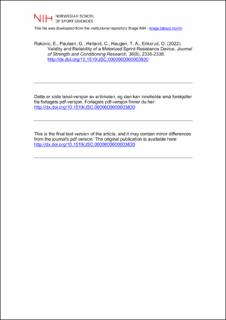| dc.contributor.author | Rakovic, Elvir | |
| dc.contributor.author | Paulsen, Gøran | |
| dc.contributor.author | Helland, Christian | |
| dc.contributor.author | Haugen, Thomas André | |
| dc.contributor.author | Eriksrud, Ola | |
| dc.date.accessioned | 2023-02-08T08:54:53Z | |
| dc.date.available | 2023-02-08T08:54:53Z | |
| dc.date.created | 2022-01-24T07:10:22Z | |
| dc.date.issued | 2022 | |
| dc.identifier.citation | Journal of Strength and Conditioning Research. 2022, 36(8), 2335-2338. | en_US |
| dc.identifier.issn | 1064-8011 | |
| dc.identifier.uri | https://hdl.handle.net/11250/3049136 | |
| dc.description | I Brage finner du siste tekst-versjon av artikkelen, og den kan inneholde ubetydelige forskjeller fra forlagets pdf-versjon. Forlagets pdf-versjon finner du på lww.com / In Brage you'll find the final text version of the article, and it may contain insignificant differences from the journal's pdf version. The definitive version is available at lww.com. | en_US |
| dc.description.abstract | An increasing number of sprint-related studies have used motorized devices to provide resistance while sprinting. The aim of this study was to establish within-session reliability and criterion validity of sprint times obtained from a motorized resistance device. Seventeen elite, female, handball players (22.9 ± 3.0 years; 176.5 ± 6.5 cm; 72.7 ± 5.5 kg; training volume 9.3 ± 0.7 hours per week) performed two 30-m sprints under 3 different resistance loading conditions (50, 80 and 110 N). Sprint times (t0–5m, t5–10m, t10–15m, t15–20m, t20–30m, and t0–30m) were assessed simultaneously by a 1080 Sprint motorized resistance device and a postprocessing timing system. The results showed that 1080 Sprint timing was equivalent to the postprocessing timing system within the limits of precision (±0.01 seconds). A systematic bias of approximately 0.34 ± 0.01 seconds was observed for t0–5m caused by different athlete location and velocity at triggering point between the systems. Coefficient of variation was approximately 2% for t0–5 and approximately 1% for the other time intervals, although standard error of measurement ranged from 0.01 to 0.05 seconds, depending on distance and phase of sprint. Intraclass correlation ranged from 0.86 to 0.95. In conclusion, the present study shows that the 1080 Sprint is valid and reliable for sprint performance monitoring purposes. | en_US |
| dc.language.iso | eng | en_US |
| dc.subject | medical | en_US |
| dc.subject | photocells | en_US |
| dc.subject | resisted sprinting | en_US |
| dc.subject | spatiotemporal measurements | en_US |
| dc.subject | sprint conditioning | en_US |
| dc.title | Validity and Reliability of a Motorized Sprint Resistance Device | en_US |
| dc.type | Peer reviewed | en_US |
| dc.type | Journal article | en_US |
| dc.description.version | acceptedVersion | en_US |
| dc.source.pagenumber | 2335-2338 | en_US |
| dc.source.volume | 36 | en_US |
| dc.source.journal | Journal of Strength and Conditioning Research | en_US |
| dc.source.issue | 8 | en_US |
| dc.identifier.doi | 10.1519/JSC.0000000000003830 | |
| dc.identifier.cristin | 1988180 | |
| dc.description.localcode | Institutt for fysisk prestasjonsevne / Department of Physical Performance | en_US |
| cristin.ispublished | true | |
| cristin.fulltext | postprint | |
| cristin.qualitycode | 1 | |
